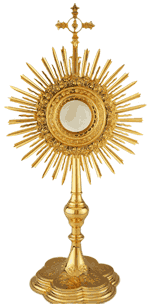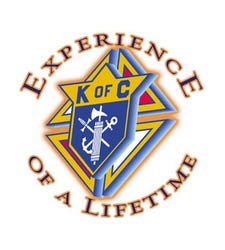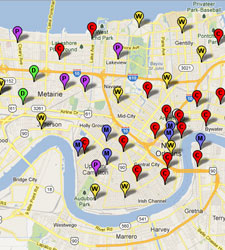Rectory 504-899-1378 | Fax 504-899-0480
School 504-891-1927
ststephenpar@archdiocese-no.org
From the Pastor – October 13, 2024
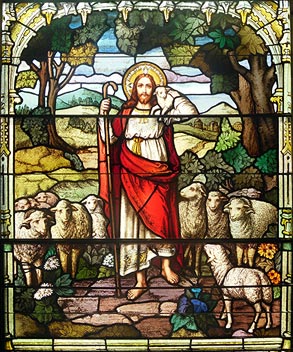 “Children, how hard it is to enter the kingdom of God! It is easier for a camel to pass through the eye of a needle than for one who is rich to enter the kingdom of God.” (Mk 10:25-26)
“Children, how hard it is to enter the kingdom of God! It is easier for a camel to pass through the eye of a needle than for one who is rich to enter the kingdom of God.” (Mk 10:25-26)
Before I entered seminary, I heard a homily preached on this Gospel passage. The priest explained that one of the gates to enter Jerusalem that was called the “eye of the needle.” Camels could only go through the “eye of the needle” if they were crawling on their knees and stripped of baggage. The implication was that we only get to Heaven “on our knees” and free of attachment to possessions. At the time, it seemed like a good explanation. But when I was in seminary studying Sacred Scripture, I learned there was no such gate. His cute story was a complete fabrication!
However, there are explanations that help us to understand the word usage of Jesus. Think about it. Why a camel and the eye of a needle? Why not an elephant and a keyhole? Maybe a blue whale and a bathtub drain? Well, one reason for the words is that rope was made from camel hair, and the Greek words are very similar: kamilos (rope) and kamelos (camel). Since rope wouldn’t fit through the eye of a sewing needle, Jesus is using both a pun and the literary device of hyperbole. It’s actually pretty funny, when you think about it! Since there’s no way that a rope, let alone a camel, can get through the eye of a needle, Jesus is basically saying it’s impossible for a rich person to get to Heaven. And that threw the Apostles for a loop. Riches were supposed to be signs of God’s favor on earth. If someone who was obviously in God’s favor (a very wealthy person) couldn’t get to Heaven, then “who can be saved?” (Mk 10:26). Far from liking the pun or the hyperbole, the Apostles were horrified that no one could be saved.
And that’s when Jesus lets them off the hook. “For human beings it is impossible, but not for God. All things are possible for God.” (Mk 10:27). Not only can God get a camel through the eye of the needle, but God can get each of us to Heaven. And His Son came to show us how He would do that. And Jesus revealed Himself as the “way” to Heaven by his life, death and resurrection.
In this week’s Gospel passage, Jesus helps us to understand that Heaven is not “here.” It’s not the material things, the comforts and the pleasures of earth. All of those things are passing away, and they can be actual hindrances to us if we strive for Heaven. They take up our time, they distract us, and they are inferior to the treasures of Heaven. Not everyone is called to voluntarily live a life of poverty, but some people are. And the ones that have done so in the most dramatic way – St. Francis of Assisi and Mother Teresa of Calcutta come to mind – are the ones that point us to share in God’s happiness here on earth rather than the fleeting happiness of earthly things. Jesus Christ gives us a happiness that the world can’t give, and a happiness that the world can’t take away. But we might never experience that happiness if we spend all of our time focusing on the fleeting happiness of created things.
(Very Rev. Msgr.) Christopher H. Nalty
msgr.nalty@gmail.com
Masses
St. Stephen
Saturday Vigil at 4:00 pm
Sunday at 8:00 am and 10:30 am
Sunday at 5:00 pm at OLGC
Our Lady of Good Counsel (OLGC)
Center of Jesus the Lord
Charismatic Mass
Sunday at 10 am
Weekdays Masses
Monday – Friday 6:30 am St. Henry
Tuesdays 6:00 pm St. Stephen
First Fridays 6:00 pm Latin Mass
Adoration of the Blessed Sacrament
Tuesdays 4:45 – 5:45pm St. Stephen
Thursdays 7:00 – 8:00am St. Henry
Confession Times at Good Shepherd
Saturdays 3:00 – 3:45pm St. Stephen
Sundays 9:30 – 10:15am St. Stephen
Sundays 10:00 – 10:30am OLGC
First Fridays 6:30 – 7:00pm OLGC
Newsletter Sign Up
Religious Education
First Holy Communion classes begin on Sunday, October 6, 2024 at 9:15am in the Rectory.
Confirmation classes begin on Sunday, November 3, 2024 after the 10:30am Mass in the Rectory.
Please contact the rectory office to register so we can ensure we have sufficient teaching materials for each student.
Please contact Msgr. Nalty directly if you or someone you know is interested in coming into full communion with the Catholic Church through the Order of Christian Initiation for Adults.
St. Francis of Assisi – Blessing of the Pets
October 6 at 11:45 am
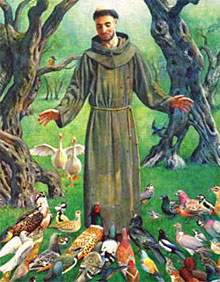
Feast Day – October 4
Many of the stories that surround the life of St. Francis of Assisi deal with his love for animals. Part of his appreciation of the environment is expressed in his Canticle of the Sun, a poem written in Umbrian Italian in perhaps 1224 which expresses a love and appreciation of Brother Sun, Sister Moon, Mother Earth, Brother Fire, etc. and all of God’s creations personified in their fundamental forms. Francis’ attitude towards the natural world, while poetically expressed, was conventionally Christian. He believed that the world was created good and beautiful by God but suffers a need for redemption because of the primordial sin of man. He preached the universal ability and duty of all creatures to praise God (a common theme in the Psalms) and the duty of men to protect and enjoy nature as both the stewards of God’s creation and as creatures ourselves. On Sunday, October 6 all pets are invited into the courtyard between the church and the school at 11:45am, after the 10:30am Mass, for the Blessing of the Pets. Please make sure that your pets play “nice” before bringing them over!
Parish Wide Confessions
September 18, 2024
5 pm – 6:30 pm
As we do every year, Archbishop Aymond has asked that each parish offer the Sacrament of Confession on the nearest Wednesday to the Feast of the Exaltation of the Cross. This year that date is September 18, 2024.
Willwoods Faith and Marriage Married Couples Retreat
September 21-22, 2024
Attention all married couples: We invite you to a weekend getaway designed to bless and enrich your faith and your marriage at the beautiful St. Joseph Abbey in Covington. You and your spouse will spend time growing closer through inspiring talks, private couple time, individual prayer time, the Sacrament of Reconciliation, Eucharistic Adoration and the celebration of the Mass! Through God’s grace, you will walk away with a renewed strength and a deeper commitment to each other and to God. To register for your relaxing and rejuvenating retreat, visit FaithandMarriage.org. A suggested donation is requested but not required. Cost should never be a reason why a couple cannot make a weekend! Scholarships are available! If you have any questions, please call (504) 830-3716 or email Jason@FaithandMarriage.org. Limited spaces are available.
Exaltation of the Holy Cross
On the week when we celebrate the Feast of the Exaltation of the Holy Cross, Archbishop Aymond has asked that every parish offer Confession for an hour and a half. To that end, on Wednesday, September 18, 2024, Confessions will be heard in the Basilica of St. Stephen beginning at 5:00pm until 6:30pm.
The North American Martyrs – October 19
The only reason we know about Jesus Christ is that someone told us. More than likely, that person was our parents, but it could have been a priest, a teacher or even a friend. And the person who told us only knew about Jesus because someone had told him or her. And someone told that person, too. And so on. We trace that chain of people passing on their knowledge of Christ back to the Apostles, who were told by Jesus to: “Go, therefore, and make disciples of all nations, baptizing them in the name of the Father, and of the Son, and of the holy Spirit, teaching them to observe all that I have commanded you. And behold, I am with you always, until the end of the age.” (Mt. 28:19-20). This statement of Jesus is called the “Great Commission” – the instruction of the resurrected Jesus Christ to his Apostles to spread His teachings to everyone. It is an important tenet in Christian theology emphasizing mission work, evangelism, and baptism; and it is the primary basis for Christian missionary activity today.
The interesting thing about missionary activity is the danger that has surrounded it since the beginning. Out of the eleven Apostles charged with the Great Commission, only St. John died of natural causes. The rest were martyrs. From the first century to the twentieth century, this has stood true. As the theologian Tertullian observed around the year 200 A.D.: “We have become more numerous every time we are hewn down by you. The blood of Christians is the seed.” (“Semen est sanguis Christianorum”).
As I stated in a recent weekday homily, one of the problems we face in America is the lack of martyrs. Compared to many countries, we received our Christianity in America fairly easily, and sometimes when things are easily obtained, they’re not appreciated as well. Although we know we’re of the same faith as the martyrs Peter & Paul in the first century and the martyr Maximillian Kolbe in the last century, their tombs are not among us. But we can at least recognize a few, the North American Martyrs, a group of eight Jesuit missionaries who spread the Faith among the Indians of Canada in the 17th century, and paid the price with their lives.
Next weekend we celebrate “World Mission Sunday,” and on the Wednesday before we remember the North American Martyrs: Sts. John de Brebeuf, Isaac Jogues and their companions. These early Jesuit missionaries arrived in Quebec in 1625. Initially, their work was with the French settlers and traders and evangelizing the nearby Indians. Soon they extended their missionary efforts to the Huron nation about 800 miles west of Quebec (about 100 miles north of present-day Toronto.)
Trouble soon came from the hostile Iroquois nation to the southeast, which began ambushing the supply route between Huronia and Quebec. In 1642, Father Isaac Jogues and Rene Goupil were captured on a return trip to Sainte Marie from Quebec. Father Goupil was martyred while making the sign of the cross on a child. Father Jogues had his fingers eaten and was enslaved. Although he escaped and returned to France (where the Pope gave him special permission to say Mass without his fingers), he returned to the mission – and was subsequently martyred in 1646 (in present day New York).
The North American Martyrs were canonized by Pope Pius XI in 1930. Their feast day is celebrated on October 19th in the United States. Those of us in the “developed” world would do well to remember these martyrs and the sacrifice of their blood which became the seed for the Church in our own country. And recognizing that the Gospel has not yet reached all nations, it is our obligation to support missionary activity in the “undeveloped” world.
Our Lady of the Rosary
October 7
In 1571 Pope Pius V instituted “Our Lady of Victory” as an annual feast to commemorate the victory of Lepanto, where Christian forces successfully thwarted an attempted invasion of Western Europe by the Muslim forces of the Ottaman Empire. The victory was attributed to the Blessed Virgin Mary, as a Rosary procession had been offered on that day in St. Peter’s Square in Rome for the success of the mission of the Holy League. In 1573, Pope Gregory XIII changed the title of this feast-day to “Feast of the Holy Rosary”. This feast was extended by Pope Clement XII to the whole of the Latin Rite, inserting it into the Roman Catholic calendar of saints in 1716, and assigning it to the first Sunday in October. Pope Pius X changed the date to 7 October in 1913, as part of his effort to restore celebration of the liturgy of the Sundays.
Respect Life Sunday
A Prayer for Life to Jesus in the Blessed Sacrament
O Jesus, you came that we might have life—and have it in abundance. Together with the Father and the Holy Spirit, you form us in our mothers’ wombs and call us to love you for all eternity.
As your most precious gift of human life is attacked, draw us ever closer to your Real Presence in the Eucharist. Dispel the darkness of the culture of death, for you are the light that shines in the darkness, and the darkness cannot overcome it.
By the power of your Eucharistic Presence, help us to defend the life of every human person at every stage. Transform our hearts to protect and cherish all whose lives are most vulnerable.
For you are God, forever and ever. Amen.
Blessed Francis Xavier Seelos Feast Day – October 5
Born in Füssen, Bavaria, in 1809, Francis Xavier Seelos was well educated and had a special gift for languages, but his most outstanding characteristic was his humility. He was ordained a Redemptorist priest in Baltimore, Maryland in 1844. Always loyal to the Order’s charism, he was at heart a “missionary with a constant smile on his lips and a generous heart, particularly toward the needy and outcasts,” his followers said. His confessional was always open to everyone, and he heard confessions in German, English, and French, from anyone, regardless of their ethnicity. As a priest, he was distinguished for his “simple lifestyle and language,” so much so that his sermons were heard and understood even by the most simple. Of all the souls entrusted to his care, the ones he was especially fond of were the children. He considered the catechesis of children “fundamental for the Christian growth of the parish community.”
In 1860, when Bishop Michael O’Connor of Pittsburgh was leaving the diocese, he “nominated” Seelos as his most reliable successor. However, Father Seelos wrote Pope Pius IX, begging him to free him “from this act of God.” When the Civil War broke out in the United States new laws were passed regarding military service. In 1863 all men were obliged to be available for active duty. At the time, Seelos was Superior of the Redemptorist Seminary. He went to Washington to meet President Abraham Lincoln and was successful in releasing the Seminary students from being sent to the front. Seelos lost his position as Prefect of Students shortly thereafter, for being “too lenient” with youth. As a result, from 1863 to 1866 Francis Xavier Seelos devoted himself to itinerant missionary work, preaching in English and German in many parts of the United States. He died in New Orleans on October 4, 1867 of yellow fever at only 48 years of age, spending several weeks “patiently and light-heartedly tolerating the illness.” His mortal remains are in our neighboring parish of St. Mary’s Assumption at the National Shrine of Blessed Francis Xavier Seelos.
Home Middle #3 Widget
This is a widgeted area which is called Home Middle #3. It is using the Genesis - Featured Page widget to display what you see on the Metric child theme demo site. To get started, log into your WordPress dashboard, and then go to the Appearance > Widgets screen. There you can drag the Genesis - Featured Page widget into the Home Middle #3 widget area on the right hand side. To get the image to display, simply upload an image through the media uploader on the edit post screen and publish your page. The Featured Page widget will know to display the post image as long as you select that option in the widget interface.
Copyright © 2024 Good Shepherd Parish · New Orleans WordPress site hosting and maintenance provided by Amaze Media | Privacy Policy

